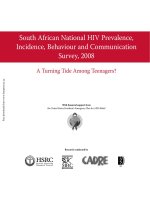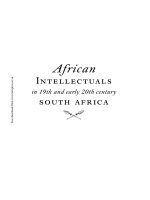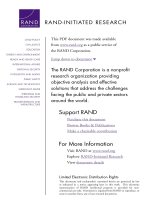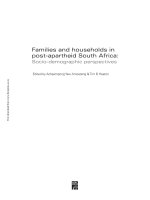South Africa''''s role in conflict resolution and peacemaking in Africa docx
Bạn đang xem bản rút gọn của tài liệu. Xem và tải ngay bản đầy đủ của tài liệu tại đây (1.27 MB, 280 trang )
Free download from www.hsrcpress.ac.za
Free download from www.hsrcpress.ac.za
Free download from www.hsrcpress.ac.za
Commissioned by the Nelson Mandela Foundation
and compiled by the Human Sciences Research Council
Published by HSRC Press
Private Bag X9182, Cape Town, 8000, South Africa
www.hsrcpress.ac.za
© 2006 Human Sciences Research Council
First published 2006
All rights reserved. No part of this book may be reprinted or reproduced or utilised in any
form or by any electronic, mechanical, or other means, including photocopying
and recording, or in any information storage or retrieval system, without permission
in writing from the publishers.
ISBN 0-7969-2129-6
Typeset by Stacey Gibson
Cover by Farm
Cover photograph by Guy Tillim
Print management by comPress
Distributed in Africa by Blue Weaver
PO Box 30370, Tokai, Cape Town, 7966, South Africa
Tel: +27 (0) 21 701 4477
Fax: +27 (0) 21 701 7302
email:
www.oneworldbooks.com
Distributed in Europe and the United Kingdom by Eurospan Distribution
Services (EDS)
3 Henrietta Street, Covent Garden, London, WC2E 8LU, United Kingdom
Tel: +44 (0) 20 7240 0856
Fax: +44 (0) 20 7379 0609
email:
www.eurospanonline.com
Distributed in North America by Independent Publishers Group (IPG)
Order Department, 814 North Franklin Street, Chicago, IL 60610, USA
Call toll-free: (800) 888 4741
All other enquiries: +1 (312) 337 0747
Fax: +1 (312) 337 5985
email:
www.ipgbook.com
Free download from www.hsrcpress.ac.za
Contents
List of tables and figures v
Foreword vi
Acknowledgements vii
Acronyms and abbreviations viii
1. Introduction: South Africa, an African peacemaker? 1
Roger Southall
2. Power and peace: South Africa and the refurbishing of Africa’s
multilateral capacity for peacemaking 27
Peter Kagwanja
3. Lost between stability and democracy: South Africa and Lesotho’s
constitutional crises of the 1990s 59
Nthakeng Selinyane
4. Commodifying oppression: South African foreign policy towards
Zimbabwe under Mbeki 85
Dale McKinley
5. A long prelude to peace: South African involvement in ending
Burundi’s war 105
Roger Southall
6. Disarmament, demobilisation and reintegration during the transition in
Burundi: a success story? 135
Henri Boshoff
7. South Africa and the DRC: is a stable and developmental state possible in
the Congo? 151
Claude Kabemba
Free download from www.hsrcpress.ac.za
8. South Africa in peacemaking in West Africa 173
Ishola Williams
9. Dealing with Africa’s post-independence past: truth commissions, special
courts, war-crimes trials and other methods 191
John Daniel and Marisha Ramdeen
10. Ten principles of best practice engagement for Africa and
South Africa 219
Hussein Solomon
11. A gendered perspective on principles and the South African practice
of peacemaking 237
Alison Lazarus
12. The South African arms industry: redefining the boundaries 253
Sanusha Naidu
Contributors 266
Free download from www.hsrcpress.ac.za
List of tables and figures
Tables
Table 6.1 Responsibilities for activities in the demobilisation
process 143
Table 6.2 Steps, observations and actors in the demobilisation
process 145
Table 6.3 Numbers of ex-combatants of parties other than
CNDD-FDD still in the pre-disarmament assembly areas
(PDAAs) 146
Table 6.4 Numbers of ex-combatants and ex-FAB already
demobilised 146
Table 6.5 Projected numbers of ex-combatants and ex-FAB still to
be demobilised 147
Table 6.6 Numbers of ex-combatants currently in the
cantonment sites 147
Table 6.7 Numbers of ex-combatants and ex-FAB integrated into
the BNDF/BNP 147
Table 6.8 Numbers of ex-combatants demobilised to date (totals
per group, 31 May 2005) 148
Table 10.1 Conflict prevention: phases, actions and goals 223
Table 12.1 Top ten destinations for South African arms exports,
1996–1998 (R’000) 258
Figures
Figure 6.1 Overview of DDR activities in Burundi 142
Figure 12.1 Approvals granted for arms sales in 2001, by region 259
vii
Free download from www.hsrcpress.ac.za
Foreword
This collection is a product of a research workshop conducted on behalf of the
Nelson Mandela Foundation by the Democracy & Governance (D&G) Research
Programme of the Human Sciences Research Council (HSRC) and the Africa
Institute of South Africa, which was held in December 2004. It is a sequel to a
previous project that examined the particular contribution made by Former
President Nelson Mandela to bringing about the present political settlement
in Burundi, a country that had been wracked by civil war since the early 1990s.
Conducted by Kristina Bentley and Roger Southall, and published as An African
peace process: Mandela, South Africa and Burundi (HSRC Press, 2005), this
provided the Foundation’s first opportunity to foster its interest in studying the
principles and practices that can be pursued by South Africa and other African
countries in attempts to resolve conflicts and establish peace on our continent.
This wide-ranging collection assesses the South African government’s
involvement in promoting peace in a number of political conflicts in Lesotho,
Zimbabwe, the Democratic Republic of Congo and West Africa, as well as
Burundi, whilst also attempting to analyse its motivations and capacities for
doing so. Importantly, too, the collection examines the extent to which the
South African model of negotiation and reconciliation can be exported to
other countries and, if so, why that should be. This latter aspect we regard as
particularly important, for while the Nelson Mandela Foundation is proud of
sponsoring research, its objective is practical rather than academic: to borrow
the HSRC’s own slogan, it is concerned to promote ‘social science that makes a
difference’. There can be few more important objectives than helping to end the
conflicts that have torn various of Africa’s countries apart. It is only upon a basis
of lasting peace that the development and growth that is so important to Africa’s
people can take place.
I would like to thank the D&G Research Programme, the Africa Institute of
South Africa, the editor and all the authors for contributing to a successful
and valuable venture.
John Samuel
Former Chief Executive Officer, Nelson Mandela Foundation
viii
Free download from www.hsrcpress.ac.za
Acknowledgements
The Africa Institute of South Africa and the Human Sciences Research Council
would like to express thanks for permission to include the following papers,
which have been or are going to be published elsewhere. A version of John
Daniel and Marisha Ramdeen’s paper, ‘Dealing with Africa’s post-independence
past: Truth commissions, special courts, war-crimes trials and other methods’,
was previously published in South African yearbook of international affairs
2003/04 (SAIIA 2004: 259–80). Dale McKinley’s paper was previously published
as ‘South African foreign policy towards Zimbabwe under Mbeki’, Review of
African Political Economy 31: 357–364. Roger Southall’s paper, ‘A long prelude to
peace: African involvement in ending Burundi’s war’, is to be published in Oliver
Furley and Roy May, Ending Africa’s wars (Ashgate 2006).
I would also like to thank the Nelson Mandela Foundation for its generosity in
funding this project, and for hosting the workshop at its premises in Houghton.
As ever, the then Chief Executive Officer John Samuel was unfailingly helpful,
and has been remarkably patient during the extended editorial period. Eddie
Maloka and Pierre Hugo of the Africa Institute provided invaluable assistance
in the organisation of the workshop, as did Gray van den Bergh and Joan
Makalela of the Democracy & Governance Programme of the HSRC. A huge
debt is also owed to Louise Torr for her thoroughness and intelligence in
rendering the diverse papers into a coherent manuscript.
Roger Southall
Human Sciences Research Council
ix
Free download from www.hsrcpress.ac.za
Acronyms and abbreviations
AMIB African Mission in Burundi
AMIS African Mission in Sudan
ANAD L’Accord de Non-agression et de Coopération en Matière
de Défense
ANC African National Congress
APLA Azanian People’s Liberation Army
APPM Armed Political Parties and Movements (Burundi)
APRM African Peer Review Mechanism
Armscor Armaments Development and Production Corporation
of South Africa
ASF African Standby Force
AU African Union
BAC Basutoland African Congress
BCP Basutoland Congress Party
BDF Botswana Defence Force
BNP Basotho National Party
CA Constitutive Act (AU)
CIPS Centre for International Political Studies
CNDRR National Commission for Demobilisation, Reinsertion
and Reintegration (Burundi)
CNDD Conseil National pour la Défense de la Démocratie (Burundi)
Codesa Convention for a Democratic South Africa
Cosatu Congress of South African Trade Unions
CSSDCA Conference on Security, Stability, Development and
Co-operation in Africa
DC Demobilisation centre (Burundi)
DDR disarmament, demobilisation and reintegration (Burundi)
DRC Democratic Republic of Congo
ECOMOG ECOWAS Monitoring Group
x
Free download from www.hsrcpress.ac.za
ECOSOC Economic, Social and Cultural Commission
ECOWAS Economic Community of West African States
ES Executive Secretariat
EU European Union
FAB Forces Armées Burundaises
FAR Rwandan Armed Forces
FDD Force pour la Défense de la Démocratie (Burundi)
FDLR Forces Démocratiques de Libération du Rwanda
FDN National Defence Force (Burundi)
FNL Forces Nationales de Libération (Burundi)
FNLA National Forces for the Liberation of Angola
Frelimo Front for the Liberation of Mozambique
FRODEBU Front pour la Démocratie au Burundi
FPTP first past the post
GEAR Growth, Employment and Redistribution
ICC International Criminal Court
ICD Inter-Congolese Dialogue
ICG International Crisis Group
ICTR International Criminal Tribunal for Rwanda
IEC Independent Electoral Commission (South Africa)
IMC Implementation Monitoring Committee (Burundi)
IMF International Monetary Fund
IPA Interim Political Authority (Lesotho)
IPKF Indian Peacekeeping Force
IRC International Red Cross
IRIN Integrated Regional Information Network
JCC Joint Ceasefire Commission (Burundi)
JLT Joint Liaison Team (Burundi)
JOP Joint Operational Plan for Pre-Disarmament, Combatant
Verification, Military Integration and Demobilisation of
Armed Movements (Burundi)
JRC Justice and Reconciliation Commission (Morocco)
xi
ACRONYMS AND ABBREVIATIONS
Free download from www.hsrcpress.ac.za
LCD Lesotho Congress for Democracy
LCN Lesotho Council of Non-Governmental Organisations
LDF Lesotho Defence Force
LLA Lesotho Liberation Army
LHWP Lesotho Highlands Water Project
LPC Lesotho People’s Congress
MDC Movement for Democratic Change (Zimbabwe)
MDRP Multi-Country Demobilisation and Reintegration
Programme (Burundi)
MFP Marematlou Freedom Party (Lesotho)
MLC Mouvement pour la Libération du Congo (DRC)
MONUC UN Mission in the DRC
MP Member of Parliament
MPLA Popular Movement for the Liberation of Angola
NCA National Constitutional Assembly (Zimbabwe)
NCACC National Conventional Armaments Control Committee
Nepad New Partnership for Africa’s Development
NGO non-governmental organisation
NIEC National Independent Electoral Commission (Burundi)
NP National Party
NPDRR National Plan for Demobilisation, Reinsertion and
Reintegration (Burundi)
NRC National Reconciliation Commission (Ghana)
OAU Organisation of African Unity
OECD Organisation for Economic Co-operation and Development
ONUB United Nations Operations in Burundi
OPDS Organ for Politics, Defence and Security (SADC)
OSCE Organisation on Security and Cooperation in Europe
PALIPEHUTU Parti pour la Libération du Peuple Hutu (Burundi)
PANAFSTRAG Pan-African Strategic and Policy Research Group
PDC Parti Démocrate Chrétien (Burundi)
PFD Popular Front for Democracy (Lesotho)
xii
SOUTH AFRICA’S ROLE IN CONFLICT RESOLUTION AND PEACEMAKING IN AFRICA
Free download from www.hsrcpress.ac.za
PGP Patriotic Grouping for Peace (Côte d’Ivoire)
PMC Private Military Company
PPRD Parti du Peuple pour la Reconstruction et le Développement
(DRC)
PR Proportional Representation
PSC Peace and Security Council (AU)
PSD Peace and Security Directorate (AU)
RCD Rassemblement Congolaise pour la Démocratie (DRC)
RDR Rally of the Republicans (Côte d’Ivoire)
RPF Rwandan Patriotic Front
RUF Revolutionary United Front (Sierra Leone)
SA South Africa
SACP South African Communist Party
SADC Southern African Development Community
SADF South African Defence Force
SANDF South African National Defence Force
SAPS South African Police Service
Sasol South African Coal, Oil and Gas Company
SAWID South African Women in Dialogue
SPLA/M Sudanese People’s Liberation Army/Movement
SPO Special Prosecutors Office (Ethiopia)
SSR security sector reform
TGE Transitional Government of Ethiopia
TGoB Transitional Government of Burundi
TRC Truth and Reconciliation Commission
UMEOA Union Economique et Monétaire de l’Afrique de l’Ouest
UN United Nations
UNDAW UN Division for the Advancement of Women
UNHCHR UN High Commissioner for Human Rights
Unicef United Nations Children’s Fund
UNIFEM United Nations Development Fund for Women
Unita National Union for the Total Independence of Angola
xiii
ACRONYMS AND ABBREVIATIONS
Free download from www.hsrcpress.ac.za
xiv
UNMIS United Nations Mission in Sudan
UPRONA Union pour le Progrès National (Burundi)
Zanu-PF Zimbabwe African National Union-Patriotic Front
SOUTH AFRICA’S ROLE IN CONFLICT RESOLUTION AND PEACEMAKING IN AFRICA
Free download from www.hsrcpress.ac.za
CHAPTER 1
Introduction
South Africa, an African peacemaker?
Roger Southall
The foreign policy of the present South African government continues to
live in the malign shadow cast by the former regime. Before 1994, ‘Pretoria’
stood for white power and economic dominance over the southern African
subcontinent, backed by the threat and active deployment of military force
against neighbouring states deemed to be giving succour to the African
National Congress (ANC) and other forces working for the overthrow
of apartheid. ‘Pretoria’ symbolised racism, force, lies, covert operations
and brutality; in short, it represented the antithesis of human rights. Not
surprisingly, once the ANC moved into office in 1994, it wished to distance
itself as far as possible from the past, to identify South Africa with the
promotion of human rights, and to abandon hegemony in favour of a more
egalitarian relationship with the region, as well as the pursuit of peace and
development, notably on the African continent.
Yet, in an early debate, there were those who argued that in the ‘real world’
of diplomacy, the simplistic application of human rights principles would
have to be mediated by highly complex rules and practices. Simultaneously,
the domestic demands being placed upon the post-apartheid order would
be so great that a popularly responsive government could not be expected
to prioritise an international human rights agenda over the urgency of
reconstruction and development (for a review, see Bischoff & Southall
1999). The practical outcome, perhaps inevitably, was mixed, with important
gestures, such as South Africa’s cancellation of Namibia’s apartheid-era debt
and a public expression of atonement for Pretoria’s past sins to the people
of Mozambique, combined with what one commentator more severely
judged to have been ‘more continuity than change, and the adoption of a
traditional western diplomacy’ based upon perceived national interest (Daniel
1995: 34). Retrospectively, however, after more than ten years of democracy
1
Free download from www.hsrcpress.ac.za
SOUTH AFRICA’S ROLE IN CONFLICT RESOLUTION AND PEACEMAKING IN AFRICA
2
we can see that the tension between pragmatism and principle in Pretoria’s
foreign policy remains. This is illustrated, most notably, in regard to South
Africa’s various interventions in Africa, with, for instance, considerable soul-
searching going on about whether the outcome of the remarkable rush of
South African investment into the continent will be less of a contribution to
African development than to the de facto establishment of a new economic
hegemony (Daniel, Naidoo & Naidu 2003). Meanwhile, further debate centres
around the motivations for, and effectiveness of, South Africa’s efforts to bring
peace to various countries of Africa. Motivated by the particular concerns of
the Nelson Mandela Foundation, it is to this particular discussion that the
present collection is directed.
As is all too well known, Africa’s wars and conflicts – whether fanned into
flame by the Cold War or ignited by more local causes – have been many,
brutal, often intractable and always damaging to any prospect of human
development. It was inevitable that a democratic South Africa, a country that
was regularly hailed for ‘the miracle’ of its internally negotiated settlement
between hitherto sworn enemies, represented principally by the former ruling
National Party (NP) and the ANC, would be drawn into the business of
conflict resolution and peacemaking in Africa, not least because of the iconic
status of Nelson Mandela, who during his presidency (1994–1999) embodied
forgiveness and reconciliation. Furthermore, South Africa was seen as having
not only a moral obligation to ‘repay’ Africa for sins of the apartheid regime,
but also the resources – economic and military – with which to undertake
serious continental responsibilities. There is no doubt, too, that the United
States, the remaining ‘superpower’, was joined by the European Union in
looking to South Africa to assume the role of a regional hegemon, taking on
the responsibility of leading and cajoling African states, especially those in
southern Africa, into adopting ‘democratic’ ways and soundly pro-market
economic policies. Yet this posed a considerable number of dilemmas for the
new South African government. In African terms, it was still the new kid on
the block, so how could it assume a leadership role without causing offence
to entrenched interests? If it were to deploy its considerable diplomatic,
economic and military weight to pursue contentious foreign policy goals
throughout the region, would it not be accused of acting like its arrogant
predecessor? If it supported democratic aspirations and condemned African
tyrants, how would it be able to avoid being labelled a proxy of the West?
Free download from www.hsrcpress.ac.za
3
And while South Africa’s own recent experience of negotiating a political
settlement might well be illuminating, how much purchase would it have in
other conflict-torn countries?
The background of the ANC and South Africa’s power and status – as a
‘middle power’ globally and as a ‘great power’ continentally (Van Aardt 2004)
– was such that the new regime could not avoid attempting to find answers to
these questions. Indeed, it was soon to be thrust into seeking to resolve them,
notably with regard to its becoming involved in conflict resolution, peace
enforcement, peacekeeping and peacemaking initiatives, for it was called upon
to respond to a variety of crises in African states.
This collection attempts to trace and debate this evolution through a series
of overviews of key aspects of South Africa’s involvement in attempts to
bring various African wars and conflicts to an end, alongside analyses of
its engagements in particular countries. Efforts to identify ‘best practice’
accompany the examination of South Africa’s successes, and its failures; and
with regard to its interventions in Lesotho and Zimbabwe, at least, old and
contemporary controversies are joined. After highlighting key issues raised by
the contributions, this introduction will conclude by identifying challenges
for South African foreign policy and for analysts of its conduct.
South Africa’s multilateralism
Rok Ajulu, writing in 2001, argued that while President Thabo Mbeki’s
ambitions to lead an African Renaissance demand that South Africa develops a
high profile in Africa, its various foreign policy initiatives on the continent – ‘in
respect of Zaire, Nigeria, the Great Lakes, the Democratic Republic of the Congo,
and Lesotho – have not met with spectacular success’, and he proposed that if it
was to do better in the future, ‘it would need to develop a better understanding
of the problems and sensibilities of the continent’ (Ajulu 2001: 40). Some four
years later, in this volume, Peter Kagwanja sounds a somewhat more optimistic
note, suggesting that South Africa has learnt much from its early mistakes and
that it has made considerable progress towards the realisation of its continental
goals, most particularly through its commitment to multilateralism.
Kagwanja argues that under Mandela, South African foreign policy displayed
a strong human rights orientation, which, critical of Africa’s undemocratic
INTRODUCTION
Free download from www.hsrcpress.ac.za
SOUTH AFRICA’S ROLE IN CONFLICT RESOLUTION AND PEACEMAKING IN AFRICA
4
leaders, caused considerable offence throughout the continent, especially as it
lapsed on occasion into the adventurist unilateralism characteristic of the former
regime. Hence, when Mbeki took office, he turned to multilateralism as the
principal vehicle for his pan-African ambitions. Promoted as the pursuit of the
African Renaissance (which, as Ajulu stresses, is deeply rooted in past Africanist
and anti-imperialist thinking), this embedded the ANC’s new commitment to
market-based economics, seen as vital to attract foreign investment and hence
to kick-start growth, in a holistic vision geared towards promoting peace,
prosperity, sustainable development and good governance across the continent.
This was to find institutional form in the transformation of the Organisation
of African Unity (OAU) into the African Union (AU) and the launch of the
New Partnership for Africa’s Development (Nepad). Inevitably, these bodies
have subsequently become sites of struggle between different African nations.
Nonetheless, South Africa has resisted the temptation to use its economic and
military muscle to establish itself as a hegemonic power. Instead, it has opted to
use ‘soft power’, in the form of preventive diplomacy and mediation of conflicts,
and, in so doing, to enhance its own image and influence on the continent while
seeking to build the capacity of Africa’s multilateral institutions.
Under Mandela, argues Kagwanja, South Africa learned hard lessons about the
way the African continent works, and its unilateralist foreign policy invited
isolation. Mandela’s hard line against the execution of Ken Saro-Wiwa by the
Sani Abacha military regime ended unsuccessfully when the OAU declared
South Africa’s call for sanctions against Nigeria ‘un-African’. South Africa’s
efforts to broker a peace deal between President Mobutu Sese Seko and rebel
leader Laurent Kabila in Zaire in 1997 ignored the fact that the latter was on
the verge of victory and that the Mobutu regime was on the edge of collapse;
subsequently, South African preventive diplomacy proved wholly ineffective
in promoting dialogue between Kabila and rebels based in Uganda and
Rwanda, and in preventing Angola, Namibia and Zimbabwe from sending in
troops to prop up his shaky regime. South Africa’s intervention in Lesotho in
September 1998, in the wake of a disputed general election in that country,
may have restored constitutional order, but it simultaneously roused the ghost
of the former regime’s military adventurism. Meanwhile, the South African
government’s failure to rein in the white mercenaries, arms merchants and
diamond smugglers who were assisting Jonas Savimbi’s National Union for
the Total Independence of Angola (Unita) prolonged the war in Angola, with
the result that the Popular Movement for the Liberation of Angola (MPLA)
Free download from www.hsrcpress.ac.za
5
government locked South Africa out of all its peace initiatives, except in regard
to seeking its support for the Lusaka Protocol of 1994 and its efforts to isolate
Unita diplomatically during 1998–2002.
Kagwanja views Mbeki’s turn to multilateralism as a strategy to reverse the
ineffectiveness of the unilateralism of the Mandela era. Yet he is unable to
present it as an unproblematic transformation of failure into success, with
Zimbabwe being its major stumbling block. The deep suspicion, and indeed
resentment, of South Africa by Mugabe’s Zimbabwe delayed consensus around
a mutual defence pact until August 2003. This difficult relationship transformed
itself into South Africa’s controversial policy of ‘quiet diplomacy’ towards the
drawn-out political and economic crisis in Zimbabwe. While critics decry this
as ineffective and as conducted with a total disregard for the Mugabe regime’s
abuse of human rights and democracy, Pretoria insists it is the only way to
prevent state collapse, and that to adopt strong-arm tactics would reinforce
the image of South Africa as the regional bully. Yet the Mugabe regime lives
on, and Kagwanja notes that after its overwhelming victory in the March 2005
parliamentary elections (conducted within a highly repressive environment),
the future of ‘quiet diplomacy’ has been thrown into serious doubt.
Kagwanja argues that, notwithstanding the huge problem of Zimbabwe,
Mbeki’s foreign policy played a leading role in transforming the OAU into the
AU, which he sees as having been facilitated by an accommodation of interests –
and the forging of a powerful partnership – between South Africa and
Nigeria. Within this context, the AU has ‘provided the Mbeki administration
with an ideal multilateral vehicle for its peace and security objectives’, even
though manipulation of suspicions of its hegemonic ambitions has enabled
Libya and Zimbabwe to weaken key aspects of its more liberal intentions,
notably the African Peer Review Mechanism (APRM). Nonetheless, despite
old-guard attempts to contain the scope of the AU’s new peace and security
architecture, the latter bears the strong imprimatur of South Africa’s liberal
activism, notably with regard to provision for an African Standby Force, which –
rather than simply being restricted to defending Africa from external threats –
is envisioned by Mbeki and other ‘Young Turks’ as having the capacity to
intervene in the continent’s festering internal conflicts.
It is within the spirit of this accomplishment that South Africa has played a
major role in steering the peace processes in both Burundi and the Democratic
Republic of the Congo (DRC), while also strongly backing AU initiatives with
INTRODUCTION
Free download from www.hsrcpress.ac.za
SOUTH AFRICA’S ROLE IN CONFLICT RESOLUTION AND PEACEMAKING IN AFRICA
6
regard to the implementation of the comprehensive agreement between the
Khartoum government and the Sudanese People’s Liberation Army/Movement
(SPLA/M). Given the failure of the Economic Community of West African
States (ECOWAS) and the French government to secure peace between the
government and rebels in the Ivory Coast, South Africa is now serving as
mediator in that country, although much remains to be done before this effort
can be proclaimed a success. Backed up, recently, by concerted efforts to control
a resurgence of mercenary activities emanating from within South Africa (which
were highlighted when Pretoria moved to secure the arrest of mercenaries
headed for Equatorial Guinea to topple President Obiang Mbasongo in March
2004), these various peacemaking efforts, nonetheless, seem to be contradicted
by what are clearly inadequate controls over South Africa’s arms industry, which
appears guilty of exporting arms to many of the continent’s trouble spots.
Kagwanja concludes his impressive survey by reflecting upon the limits of an
African middle power, reiterating his principal argument that while South
Africa may be an economic and military giant compared to its poorer and
weaker neighbours, its capacity to use its power in support of its liberal
internationalism tied to human rights and democratic development has been
severely limited by suspicions about its credentials, namely that it is bent
upon establishing itself as a regional hegemon implementing a too-obviously
Western agenda. Quoting Alden and Le Pere (2004: 29), Kagwanja notes that
‘this has forced the Mbeki administration to abandon the unilateralism and
moral rectitude that underpinned the Mandela presidency and turn resolutely
to multilateralism as the preferred instrument of realising South Africa’s goals
in Africa’. Although he acknowledges that this multilateralism faces many
complex challenges, Kagwanja insists that its future is bright.
Case studies
The six studies we include allow us to trace the movement from unilateralism
to multilateralism in some detail, although only the study of South Africa’s
intervention in Lesotho in 1998 deals with the foreign policy of the Mandela
presidency and falls unambiguously into the unilateralist period. Nonetheless,
as indicated in Dale McKinley’s paper on Zimbabwe – in which he argues
that the policy of ‘quiet diplomacy’ is dictated primarily by South Africa’s
corporate interests – there is no sharp divide between the two strategies.
Free download from www.hsrcpress.ac.za
7
Lesotho
South Africa’s dispatch of troops to Lesotho in September 1998, a move that
effectively restored the Lesotho Congress for Democracy (LCD) to power
in the face of opposition protest and upheaval in the wake of a disputed
general election, has been widely condemned by critics as an unfortunate and
unnecessary return to the regional bullying tactics of the apartheid regime
by the Mandela government. It is certainly the incident that is most widely
cited as illustrating South Africa’s unilateralism, although as Kagwanja has
made plain, the inadequacies of Pretoria’s initial forays into the DRC (then
still Zaire) were actually of far greater regional consequence. A large part
of the problem is that the actual intervention in Lesotho was botched. The
troops of the South African National Defence Force (SANDF) had inadequate
intelligence, orders and objectives, with the result that angry protesters were
not prevented from burning down South African-related and government
buildings in the capital, Maseru, and other towns, while an operation that
went awry led to the unnecessary deaths of some 16 Basotho troops at the
Katse Dam.
Commentary on the intervention has been overwhelmingly condemnatory
(see, for example, FDG 1998). However, my own perspective, which comes
from my stance as an observer of Lesotho’s complex and tangled politics
over the last three decades of the previous century, is that South Africa’s
intervention was ‘an unlikely success’ (Southall 2003a). In contrast to the
widespread portrayal of the protests in Maseru as popularly driven against the
result of the April election, which saw the LCD win all but one parliamentary
seat, I argue that the protests were overwhelmingly unrepresentative of
popular opinion, and had been deliberately whipped up by political leaders
who, although having been roundly trounced in an election that had been
declared free and fair by teams of highly respectable international observers,
nonetheless wanted the result annulled. Consequently, as the legitimately
elected government was in danger of being overthrown by a military that was
largely aligned with opposition forces, its plea to South Africa (formally acting
on behalf of the Southern African Development Community) to intervene to
save it was legitimate, even if there is continuing debate about its strict legality
(see Levitt 2001, however, for a strong argument that the intervention was in
accordance with international law).
INTRODUCTION
Free download from www.hsrcpress.ac.za
SOUTH AFRICA’S ROLE IN CONFLICT RESOLUTION AND PEACEMAKING IN AFRICA
8
Of course, the situation was unnecessarily messy, and controversy continues
to dog the content of the report by South African Justice Pius Langa, which
(prior to the intervention) sought to assess the conduct and outcome of the
election, its published version ambiguously declaring that the election could
not be declared unfair (Langa Commission 1998). There are widespread
allegations, favoured particularly in opposition quarters, that an earlier
version of the report, which was far more condemnatory of the election,
was politically doctored to favour the incumbent government. These, it has
to be said, remain unproven, and their final validation or rejection must
probably await the lapse of confidentiality of key archives in 20 to 30 years
time. However, it is probably far more apt to observe that the Langa Report,
rather than being a whitewash, was either an incompetent document,
overwhelmingly ignorant of Lesotho’s electoral and party politics, or one that
for political reasons was frightened to make a forthright judgement. Certainly,
I have yet to see any serious analyst confront or reject the arguments of myself
and Roddy Fox that, in the first place, the 1998 election results were wholly
consistent with the political, demographic and geographic patterns of voting
in the previous election of 1993 and that, in the second place, even allocation
of all alleged ‘ghost votes’ to opposition parties would not have altered the
overall outcome, merely reducing the number of seats that the LCD won on
election day from 79 (out of 80 seats) to 75 (Southall & Fox 1999). Whatever
the case, over the course of the following four years South Africa oversaw a
contentious process of inter-party negotiation and reform of the military that
culminated in the adoption of a new Mixed Member Proportional Electoral
system. This provided the basis for a more politically inclusive electoral
outcome in the general election of 2002.
Although Kagwanja cites South Africa’s armed intervention in Lesotho as a
key indicator of Pretoria’s unilateralism under Mandela, his view needs to be
supplemented by recognition that Lesotho’s wholly encircled, impoverished
and dependent status renders it something of a special case. I have argued
elsewhere that, in essence, Lesotho has now become a South African
protectorate (Southall 2003b), and this is a line of analysis taken up by
Nthakeng Selinyane in his own detailed analysis of the events of 1998.
Selinyane argues that relations between Lesotho and South Africa have
come full circle since the former country became independent in 1966, from
cordiality in the 1960s and early 1970s, through tension and confrontation in
Free download from www.hsrcpress.ac.za
9
the mid-1970s and 1980s, to a thawing thereafter resulting in ‘current active
co-operation’. Yet key to understanding present relations, he also suggests,
is South Africa’s strategic interest in the massive Lesotho Highlands Water
Project (LHWP) for the sale of water from Lesotho’s highlands to Gauteng.
Today, this dictates the ‘tone of relations’ between the two countries, which can
be characterised as Lesotho’s subjection to South Africa’s benign hegemony.
There are important aspects of Selinyane’s interpretation of the internal
elements of the crisis that require serious attention. He views the post-1993
Basutoland Congress Party (BCP) government as having severely mishandled
its treatment of both the defence force and its own Lesotho Liberation Army;
further, it is seen as having bungled its relations with the monarchy, and hence
raising political tensions. The BCP is accused of squandering its popular
goodwill during its first term, and even if Prime Minister Ntsu Mokhehle’s
transmutation of his support within the BCP into the LCD prior to the 1998
election was formally constitutional, it was manifestly politically tendentious;
and yes, Selinyane is correct to note that, once it had been confirmed in power
by South Africa, the LCD sought to manipulate the inter-party negotiations
around devising a new electoral system. All these developments are evidence
to Selinyane of a tradition of elite democracy in Lesotho that views ordinary
citizens as little more than voting fodder and that encourages a fractiousness
in politics, which propelled South Africa into making as hasty a diplomatic
exit as it could.
Nonetheless, the major argument he puts forward of relevance to our present
concerns is that South Africa’s actions in and after 1998 demonstrate the
potential for Pretoria to act as a benign hegemon in order to create peace and
stability throughout the region. Now, while this is highly contentious and may
assume a military capacity that South Africa simply does not have, he does
point out the anomaly that while South Africa is regularly criticised for not
taking a stronger leadership role in defence of human rights and democracy
in cases like Zimbabwe and Swaziland, it is simultaneously condemned as
insensitive for taking strong and principled actions in the case of Lesotho.
Zimbabwe
Selinyane’s broad suggestion is that the motivation behind Pretoria’s foreign
policy is ultimately benign, but Dale McKinley does not think so – at least
INTRODUCTION
Free download from www.hsrcpress.ac.za
SOUTH AFRICA’S ROLE IN CONFLICT RESOLUTION AND PEACEMAKING IN AFRICA
10
when the dynamics underlying South Africa’s stance towards Zimbabwe are
properly considered.
There is currently no aspect of South Africa’s foreign policy that so obsesses
analysts in the media and academia as the Mbeki government’s relations with
Zimbabwe. Yet as McKinley observes, the resultant debate is flawed (he actually
terms it a discourse between the arrogant and the deaf). In South Africa, the
debate is (unevenly) divided along racial lines. Whereas the majority of whites
and the white opposition regard President Robert Mugabe’s land programme
as ‘a disingenuous and politically motivated attempt to maintain power at
the expense of white Zimbabweans’ and black Zimbabweans who do not
support the ruling Zimbabwe African National Union-Patriotic Front (Zanu-
PF), the Mbeki government and many black South Africans regard his land
policies, at core, as a genuine attempt to address one of the enduring legacies
of colonialism, namely large-scale white ownership of land at the expense of
the black majority of the population. Furthermore, this debate is replicated
at international level, with the predominantly Northern and white states
positioning themselves against Mugabe, the predominantly Southern and
black states tending to side with him. An unfortunate outcome is that black
(and other) critics who protest against the appalling human rights outcomes
of Mugabe’s policies get branded as lackeys of Western imperialism.
McKinley’s core argument is that the poverty of the debate over Zimbabwe
‘has tended to obscure any meaningful analysis of the real motivations behind
South Africa’s policy’. The South African government projects its policy
as motivated by the necessity of working to prevent a total collapse of the
Zimbabwean economy and state, arguing that this would be disastrous not
only for Zimbabweans themselves but for South Africans as well. Its approach
is driven by ‘quiet diplomacy’, on the grounds that this is the most effective
strategy, and that were South Africa to be seen to be acting as a hegemon it
would be counterproductive, alienating not only Mugabe but other concerned
African countries, whose support Pretoria must seek to mobilise.
McKinley argues that this approach assumes that the Zimbabwean economy
has not already collapsed and the country has not already lapsed into a low-
level civil war, when the evidence is otherwise. The mainspring of South
African policy, which by implication is not quite so ignorant of the true state
of affairs as present debate suggests, therefore lies elsewhere, and is to be
found in the interests of the new black bourgeoisie (tied to the interests of the
Free download from www.hsrcpress.ac.za
11
ANC), the construction and promotion of which is a key aspect of Pretoria’s
broad economic and political strategies since Mbeki became President
in 1999. Hence, for instance, a key ‘rescue package’ of close to R1 billion
offered by South Africa prior to the Zimbabwean parliamentary elections
redounded principally to the benefit of South African parastatals, which
are directly involved as operators or investors in, or suppliers to, Zimbabwe.
Meanwhile, South African private industry and interests generally are
gaining a considerable foothold in the Zimbabwean economy via the latter’s
indebtedness and South African investment and trade options. By providing
political support and legitimacy to the Mugabe regime, Mbeki’s government
is working to ensure ‘the longer-term security and expansion of South Africa’s
(capitalist) economic “investments” in Zimbabwe while simultaneously tying
the future health of Zimbabwean capitalists to South African investment and
patronage’. In short, the prolongation of the Zimbabwean crisis is facilitating
the long-term interests of a South African black bourgeoisie that is aspiring to
both regional and continental ascendancy.
Other analysts who are highly critical of the South African government’s ‘quiet
diplomacy’ towards Zimbabwe attribute the approach to a more complex mix
of factors, with Freeman (2005) proposing that, while the present policy has
rendered Pretoria impotent, this is in considerable measure because Mbeki
is constrained by a host of political (domestic and continental) factors (see
also Sachikonye 2005). McKinley is also vulnerable to criticism that his
empirical evidence about South African economic engagement in
contemporary Zimbabwe is weak, and he ignores the costs to the South
African economy that the Zimbabwean meltdown is causing. Nonetheless, his
argument is undoubtedly one of major importance, which further research
needs to pursue.
Burundi
As this Introduction is being written, Pierre Nkurunziza, leader of the
Conseil National pour la Défence de la Démocratie – Force pour la Défense de
la Démocratie (CNDD-FDD), is in the process of taking office as president in
Burundi, having been so elected by Parliament, following a general election in
August 2005 in which his party won a large majority of seats. This constitutes
the culmination of a remarkable peace process in which South Africa played
INTRODUCTION
Free download from www.hsrcpress.ac.za









